Water buffalo
The water buffalo (Bubalus bubalis) or domestic water buffalo is a large bovid originating in the Indian subcontinent, Southeast Asia, and China. Today, it is also found in Europe, Australia, North America, South America and some African countries.[1] The wild water buffalo (Bubalus arnee) native to Southeast Asia is considered a different species, but most likely represents the ancestor of the domestic water buffalo.[2]
| Water buffalo | |
|---|---|
 | |
| Water buffaloes in Laos | |
Domesticated | |
| Scientific classification | |
| Kingdom: | Animalia |
| Phylum: | Chordata |
| Class: | Mammalia |
| Order: | Artiodactyla |
| Family: | Bovidae |
| Subfamily: | Bovinae |
| Genus: | Bubalus |
| Species: | B. bubalis |
| Binomial name | |
| Bubalus bubalis | |
| Global distribution of the water buffalo in 2004 | |
| Synonyms | |
|
Bos bubalis Linnaeus, 1758 | |
Two extant types of water buffalo are recognized, based on morphological and behavioural criteria – the river buffalo of the Indian subcontinent and further west to the Balkans, Egypt, and Italy, and the swamp buffalo, found from Assam in the west through Southeast Asia to the Yangtze valley of China in the east.[1][3] The origins of the water buffalo types are debated, although results of a phylogenetic study indicate that the swamp-type may have originated in China and was domesticated about 4,000 years ago, while the river-type may have originated in India and was domesticated about 5,000 years ago.[4] After the domestication of the water buffalo in Southeast Asia, the swamp buffalo dispersed up to the Yangtze River valley between 3,000 and 7,000 years ago.[5]
Water buffaloes were traded from the Indus Valley Civilisation to Mesopotamia, in modern Iraq, 2500 BC by the Meluhhas.[6] The seal of a scribe employed by an Akkadian king shows the sacrifice of water buffaloes.[7]
At least 130 million water buffaloes exist, and more people depend on them than on any other domestic animal.[8] They are especially suitable for tilling rice fields, and their milk is richer in fat and protein than that of dairy cattle. A large feral population became established in northern Australia in the late 19th century, and there are smaller feral herds in Papua New Guinea, Tunisia, and northeastern Argentina.[1] Feral herds are also present in New Britain, New Ireland, Irian Jaya, Colombia, Guyana, Suriname, Brazil, and Uruguay.[9]
Taxonomy
Carl Linnaeus first described the genus Bos and the water buffalo under the binomial Bos bubalis in 1758; the species was known to occur in Asia and was held as a domestic form in Italy.[10] Ellerman and Morrison-Scott treated the wild and domestic forms of the water buffalo as conspecifics,[11] whereas others treated them as different species.[12] The nomenclatorial treatment of the wild and domestic forms has been inconsistent and varies between authors and even within the works of single authors.[13]
In March 2003, the International Commission on Zoological Nomenclature achieved consistency in the naming of the wild and domestic water buffaloes by ruling that the scientific name Bubalus arnee is valid for the wild form.[14] B. bubalis continues to be valid for the domestic form and applies also to feral populations.[15]
Characteristics
.jpg)

The skin of the river buffalo is black, but some specimens may have dark, slate-coloured skin. Swamp buffaloes have a grey skin at birth, but become slate blue later. Albinoids are present in some populations. River buffaloes have comparatively longer faces, smaller girths, and bigger limbs than swamp buffaloes. Their dorsal ridges extend further back and taper off more gradually. Their horns grow downward and backward, then curve upward in a spiral. Swamp buffaloes are heavy-bodied and stockily built; the body is short and the belly large. The forehead is flat, the eyes prominent, the face short, and the muzzle wide. The neck is comparatively long, and the withers and croup are prominent. A dorsal ridge extends backward and ends abruptly just before the end of the chest. Their horns grow outward, and curve in a semicircle, but always remain more or less on the plane of the forehead. The tail is short, reaching only to the hocks. Height at the withers is 129–133 cm (51–52 in) for males, and 120–127 cm (47–50 in) for females. They range in weight from 300–550 kg (660–1,210 lb), but weights of over 1,000 kg (2,200 lb) have also been observed.[1]
Tedong bonga is a piebald water buffalo featuring a unique black and white colouration that is favoured by the Toraja of Sulawesi.[16]
The swamp buffalo has 48 chromosomes; the river buffalo has 50 chromosomes. The two types do not readily interbreed, but fertile offspring can occur. Water buffalo-cattle hybrids have not been observed to occur, but the embryos of such hybrids reach maturity in laboratory experiments, albeit at lower rates than non-hybrids.[17]
The rumen of the water buffalo has important differences from that of other ruminants.[18] It contains a larger population of bacteria, particularly the cellulolytic bacteria, lower protozoa, and higher fungi zoospores. In addition, higher rumen ammonia nitrogen (NH4-N) and higher pH have been found, compared to those in cattle.[19]
Ecology and behavior
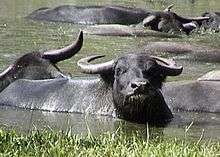
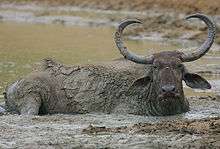
River buffaloes prefer deep water. Swamp buffaloes prefer to wallow in mudholes which they make with their horns. During wallowing, they acquire a thick coating of mud.[1] Both are well-adapted to a hot and humid climate with temperatures ranging from 0 °C (32 °F) in the winter to 30 °C (86 °F) and greater in the summer. Water availability is important in hot climates, since they need wallows, rivers, or splashing water to assist in thermoregulation. Some water buffalo breeds are adapted to saline seaside shores and saline sandy terrain.[20]
Diet
Water buffaloes thrive on many aquatic plants. During floods, they will graze submerged, raising their heads above the water and carrying quantities of edible plants. Water buffaloes eat reeds, Arundo donax, a kind of Cyperaceae, Eichhornia crassipes, and Juncaceae. Some of these plants are of great value to local peoples. Others, such as E. crassipes, are a major problem in some tropical valleys and by eating them, the water buffaloes may help to keep waterways clear.
Green fodders are used widely for intensive milk production and for fattening. Many fodder crops are conserved as hay, chaffed, or pulped. Fodders include alfalfa, the leaves, stems or trimmings of banana, cassava, Mangelwurzel, esparto, Leucaena leucocephala and kenaf, maize, oats, Pandanus, peanut, sorghum, soybean, sugarcane, bagasse, and turnips. Citrus pulp and pineapple wastes have been fed safely to buffalo. In Egypt, whole sun-dried dates are fed to milk buffalo up to 25% of the standard feed mixture.[1]
Reproduction
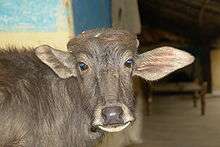
Swamp buffaloes generally become reproductive at an older age than river breeds. Young males in Egypt, India, and Pakistan are first mated at about 3.0–3.5 years of age, but in Italy they may be used as early as 2 years of age. Successful mating behaviour may continue until the animal is 12 years or even older. A good river buffalo male can impregnate 100 females in a year. A strong seasonal influence on mating occurs. Heat stress reduces libido.[1]
Although water buffaloes are polyoestrous, their reproductive efficiency shows wide variation throughout the year. Water buffalo cows exhibit a distinct seasonal change in displaying oestrus, conception rate, and calving rate.[21] The age at the first oestrus of heifers varies between breeds from 13–33 months, but mating at the first oestrus is often infertile and usually deferred until they are 3 years old. Gestation lasts from 281–334 days, but most reports give a range between 300 and 320 days. Swamp buffaloes carry their calves for one or two weeks longer than river buffaloes. It is not rare to find water buffaloes that continue to work well at the age of 30, and instances of a working life of 40 years have been recorded.[1]
Domestication and breeding
Water buffaloes were domesticated in the Indian subcontinent about 5,000 years ago, and in China about 4,000 years ago. Two types are recognized, based on morphological and behavioural criteria – the river buffalo of the Indian subcontinent and further west to the Balkans and Italy, and the swamp buffalo, found from Assam in the west through Southeast Asia to the Yangtze valley of China in the east.[3] The present-day river buffalo is the result of complex domestication processes involving more than one maternal lineage and a significant maternal gene flow from wild populations after the initial domestication events.[22] Twenty-two breeds of the river buffalo are known, including the Murrah, NiliRavi, Surti, Jafarabadi, Anatolian, Mediterranean, and Egyptian buffaloes.[23] China has a huge variety of water buffalo genetic resources, with 16 local swamp buffalo breeds in various regions.[20]
Genetic studies
Results of mitochondrial DNA analyses indicate that the two types were domesticated independently.[24] Sequencing of cytochrome b genes of Bubalus species implies that the water buffalo originated from at least two populations, and that the river-type and the swamp-type have differentiated at the full species level. The genetic distance between the two types is so large that a divergence time of about 1.7 million years has been suggested. The swamp-type was noticed to have the closest relationship with the tamaraw.[25]
Analyses of mitochondrial DNA and single-nucleotide polymorphism indicate that swamp and river buffaloes were crossbred in China.[26]
An analysis of the genomes of 91 swamp and 30 river buffaloes showed that they separated already before domestication about 0.23 million years ago.[27]
Distribution of populations

By 2011, the global water buffalo population was about 172 million.[28]
In Asia
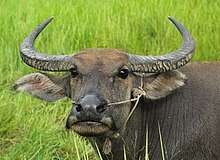
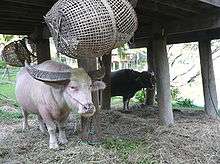
.jpg)
More than 95.8% of the world population of water buffaloes are kept in Asia, including both the river-type and the swamp-type.[20] The water buffalo population in India numbered over 97.9 million head in 2003, representing 56.5% of the world population. They are primarily of the river type with ten well-defined breeds: the Bhadawari, Banni, Jafarabadi, Marathwadi, Mehsana, Murrah, Nagpuri, Nili-Ravi, Pandharpuri, Surti and Toda buffaloes. Swamp buffaloes occur only in small areas in northeastern India and are not distinguished into breeds.[29]
In 2003, the second-largest population lived in China, with 22.76 million head, all of the swamp-type, with many breeds kept only in the lowlands, and other breeds kept only in the mountains; as of 2003, 3.2 million swamp-type Carabao buffaloes were in the Philippines, nearly three million swamp buffaloes were in Vietnam, and 772,764 buffaloes were in Bangladesh. About 750,000 head were estimated in Sri Lanka in 1997.[20] In Japan, the water buffalo is the domestic animal throughout the Ryukyu Islands or Okinawa prefecture. It was also recorded that 889,246 water buffaloes were in Nepal.
The water buffalo is the main dairy animal in Pakistan, with 23.47 million head in 2010.[30] Of these, 76% are kept in the Punjab. The rest of them are mostly kept in the province of Sindh. The water buffalo breeds used are the NiliRavi, Kundi, and Azi Kheli.[31] Karachi has the largest population of water buffaloes for an area where fodder is not grown, consisting of 350,000 head kept mainly for milking.
In Thailand, the number of water buffaloes dropped from more than 3 million head in 1996 to less than 1.24 million head in 2011.[32] Slightly over 75% of them are kept in the country's northeastern region. The statistics also indicate that by the beginning of 2012, less than one million were in the country, partly as a result of illegal shipments to neighboring countries where sales prices are higher than in Thailand.
Water buffaloes are also present in the southern region of Iraq in the Mesopotamian Marshes. The draining of the Mesopotamian Marshes by Saddam Hussein was an attempt to punish the south for the 1991 uprisings in Iraq. After 2003 and the Firdos Square statue destruction, these lands were re-flooded and a 2007 report on Maysan and Dhi Qar shows a steady increase in the number of water buffaloes. The report puts the number at 40,008 head in those two provinces.[33]
In Europe and the Mediterranean
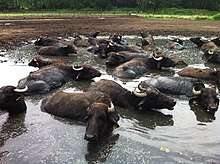
Water buffaloes were probably introduced to Europe from India or other eastern sources. In Italy, the Longobard King Agilulf is said to have received water buffaloes in about the year 600. These were probably a present from the Khan of the Avars, a Turkic nomadic tribe that dwelt near the Danube River at the time. Sir H. Johnston knew of a herd of water buffaloes presented by a King of Naples to the Bey of Tunis in the mid-19th century that had resumed the feral state in northern Tunis.[34]
European water buffaloes are all of the river-type and considered to be of the same breed named the Mediterranean buffalo. In Italy, the Mediterranean type was particularly selected and is called the Mediterranea Italiana buffalo to distinguish it from other European breeds, which differ genetically. Mediterranean buffalo are also kept in Romania, Bulgaria, Greece, Serbia, Albania, Kosovo, and North Macedonia, with a few hundred in the United Kingdom, Germany, the Netherlands, Switzerland, and Hungary. Little exchange of breeding water buffaloes has occurred among countries, so each population has its own phenotypic features and performances. In Bulgaria, they were crossbred with the Indian Murrah breed, and in Romania, some were crossbred with Bulgarian Murrah.[20] Populations in Turkey are of the Anatolian buffalo breed.[23]
In Australia
.jpg)
Between 1824 and 1849, water buffaloes were introduced into the Northern Territory from Timor, Kisar, and probably other islands in the Indonesian archipelago. In 1886, a few milking types were brought from India to Darwin. They have been the main grazing animals on the subcoastal plains and river basins between Darwin and Arnhem Land since the 1880s. In the early 1960s, an estimated population of 150,000 to 200,000 water buffaloes were living in the plains and nearby areas.[35]
They became feral and caused significant environmental damage. Water buffaloes also occur in the Top End. As a result, they were hunted in the Top End from 1885 until 1980. The commencement of the brucellosis and tuberculosis campaign (BTEC) resulted in a huge culling program to reduce water buffalo herds to a fraction of the numbers that were reached in the 1980s. The BTEC was finished when the Northern Territory was declared free of the disease in 1997. Numbers dropped dramatically as a result of the campaign, but have since recovered to an estimated 150,000 animals across northern Australia in 2008.[36]
During the 1950s, water buffaloes were hunted for their skins and meat, which was exported and used in the local trade. In the late 1970s, live exports were made to Cuba and continued later into other countries. Swamp buffaloes are now crossed with river buffaloes in artificial insemination programs, and are kept in many areas of Australia. Some of these crossbreeds are used for milk production. Melville Island is a popular hunting location, where a steady population up to 4,000 individuals exists. Safari outfits are run from Darwin to Melville Island and other locations in the Top End, often with the use of bush pilots. The horns, which can measure up to a record of 3.1 m (10 ft) tip-to-tip, are prized hunting trophies.[37]
The Australian water buffaloes have developed a different appearance from the Indonesian water buffaloes from which they descend. They live mainly in freshwater marshes and billabongs, and their territory range can be quite expansive during the wet season. Their only natural predators in Australia are adult saltwater crocodiles, with whom they share the billabongs, and dingoes, which have been known to prey on water buffalo calves and occasionally adult water buffaloes when the dingoes are in large packs.
Water buffaloes were exported live to Indonesia until 2011, at a rate of about 3,000 per year. After the live export ban that year, the exports dropped to zero, and had not resumed as of June 2013.[38]
In South America
Water buffaloes were introduced into the Amazon River basin in 1895. They are now extensively used there for meat and dairy production. In 2005, the water buffalo herd in the Brazilian Amazon stood at roughly 1.6 million head, of which 460,000 were located in the lower Amazon floodplains.[39] The breeds used include the Mediterranean from Italy, the Murrah and Jafarabadi from India, and the Carabao from the Philippines.
During the 1970s, small herds were imported to Costa Rica, Ecuador, Cayenne, Panama, Surinam, Guyana, and Venezuela.[40]
In Argentina, many game ranches raise water buffaloes for commercial hunting.
In North America
In 1974, four water buffaloes were imported to the United States from Guam to be studied at the University of Florida. In February 1978, the first herd arrived for commercial farming. Until 2002, only one commercial breeder was in the United States. Water buffalo meat is imported from Australia.[40] Until 2011, water buffaloes were raised in Gainesville, Florida, from young obtained from zoo overflow. They were used primarily for meat production, and frequently sold as hamburger.[41] Other U.S. ranchers use them for production of high-quality mozzarella cheese.[42][43][44][45] Water buffaloes are also kept in the Caribbean, specifically in Trinidad and Tobago and in Puerto Rico.
Husbandry

The husbandry system of water buffaloes depends on the purpose for which they are bred and maintained. Most of them are kept by people who work on small farms in family units. Their water buffaloes live in close association with them, and are often their greatest capital asset. The women and girls in India generally look after the milking buffaloes, while the men and boys are concerned with the working animals. Throughout Asia, they are commonly tended by children who are often seen leading or riding their charges to wallows. Water buffaloes are the ideal animals for work in the deep mud of paddy fields because of their large hooves and flexible foot joints. They are often referred to as "the living tractor of the East". It probably is possible to plow deeper with water buffaloes than with either oxen or horses. They are the most efficient and economical means of cultivation of small fields. In most rice-producing countries, they are used for threshing and for transporting the sheaves during the rice harvest. They provide power for oilseed mills, sugarcane presses, and devices for raising water. They are widely used as pack animals and, in India and Pakistan, for heavy haulage also. In their invasions of Europe, the Turks used water buffaloes for hauling heavy battering rams. Their dung is used as a fertilizer, and as a fuel when dried.[1]
Approximately 26 million water buffaloes are slaughtered each year for meat worldwide.[46] Water buffaloes contribute 72 million tonnes of milk and three million tonnes of meat annually to world food, much of it in areas that are prone to nutritional imbalances. In India, river buffaloes are kept mainly for milk production and for transport, whereas swamp buffaloes are kept mainly for work and a small amount of milk.[29]
Dairy products
Water buffalo milk presents physicochemical features different from that of other ruminant species, such as a higher content of fatty acids and proteins.[47] The physical and chemical parameters of swamp-type and river-type water buffalo milk differ.[48] Water buffalo milk contains higher levels of total solids, crude protein, fat, calcium, and phosphorus, and slightly higher content of lactose compared with those of cow milk. The high level of total solids makes water buffalo milk ideal for processing into value-added dairy products such as cheese. The conjugated linoleic acid (CLA) content in water buffalo milk ranged from 4.4 mg/g fat in September to 7.6 mg/g fat in June. Seasons and genetics may play a role in variation of CLA level and changes in gross composition of water buffalo milk.[49]
Water buffalo milk is processed into a large variety of dairy products, including:
- Cream churns much faster at higher fat levels and gives higher overrun than cow cream.[50]
- Butter from water buffalo cream displays more stability than that from cow cream.[50]
- Ghee from water buffalo milk has a different texture with a bigger grain size than ghee from cow milk.[50]
- Heat-concentrated milk products in the Indian subcontinent include paneer, khoa, rabri, kheer and basundi.[50]
- Fermented milk products include dahi, yogurt, and chakka.[50]
- Whey is used for making ricotta and mascarpone in Italy, and alkarish in Syria and Egypt.[50]
- Hard cheeses include braila in Romania, and rahss in Egypt[50]
- Soft cheeses made include mozzarella in Italy, karish, mish, and madhfor in Iraq, alghab in Syria, kesong puti in the Philippines, and vladeasa in Romania.[50]
| Top 10 water buffalo milk producers — 11 June 2008[51] | ||||
|---|---|---|---|---|
| Country | Production (tonnes) | Footnote | ||
| India | 56,960,000 | unofficial, semi-official, mirror data | ||
| Pakistan | 21,500,000 | official figure | ||
| China | 2,900,000 | FAO estimate | ||
| Egypt | 2,300,000 | FAO estimate | ||
| Nepal | 930,000 | FAO estimate | ||
| Iran | 241,500 | FAO estimate | ||
| Myanmar | 205,000 | FAO estimate | ||
| Italy | 200,000 | FAO estimate | ||
| Turkey | 35,100 | FAO estimate | ||
| Vietnam | 31,000 | FAO estimate | ||
| World | 85,396,902 | |||
Meat and skin products
Water buffalo meat, sometimes called "carabeef", is often passed off as beef in certain regions, and is also a major source of export revenue for India. In many Asian regions, water buffalo meat is less preferred due to its toughness; however, recipes have evolved (rendang, for example) where the slow cooking process and spices not only make the meat palatable, but also preserve it, an important factor in hot climates where refrigeration is not always available.
Their hides provide tough and useful leather, often used for shoes.
Environmental effects
Wildlife conservation scientists have started to recommend and use introduced populations of feral water buffaloes in far away lands to manage uncontrolled vegetation growth in and around natural wetlands. Introduced water buffaloes at home in such environs provide cheap service by regularly grazing the uncontrolled vegetation and opening up clogged water bodies for waterfowl, wetland birds, and other wildlife.[53][54] Grazing water buffaloes are sometimes used in Great Britain for conservation grazing, such as in the Chippenham Fen National Nature Reserve. The water buffaloes can better adapt to wet conditions and poor-quality vegetation than cattle.[55]
Currently, research is being conducted at the Lyle Center for Regenerative Studies to determine the levels of nutrients removed and returned to wetlands when water buffaloes are used for wetland vegetation management.
However, in uncontrolled circumstances, water buffaloes can cause environmental damage, such as trampling vegetation, disturbing bird and reptile nesting sites, and spreading exotic weeds.[56]
Research
In 2007, the development of Southeast Asia's first cloned water buffalo was announced in the Philippines. The Department of Agriculture's Philippine Carabao Center implemented cloning through somatic cell nuclear transfer as a tool for genetic improvement in water buffaloes to produce "super buffalo calves" by multiplying existing germplasms, but without modifying or altering genetic material.[57]
In January 2008, the Philippine Carabao Center in Nueva Ecija, per Filipino scientists, initiated a study to breed a super water buffalo that could produce 4 to 18 litres of milk per day, using gene-based technology. Also, the first in vitro river buffalo was born there in 2004 from an in vitro-produced, vitrified embryo, named "Glory" after President Gloria Macapagal-Arroyo. Joseph Estrada's most successful project as an opposition senator, the PCC was created through Republic Act 3707, the Carabao Act of 1992.[58]
Indian scientists from the National Dairy Research Institute, Karnal developed a cloned water buffalo in 2010. The water buffalo calf was named Samrupa. The calf did not survive more than a week, due to genetic defects. A few months later, a second cloned calf named Garima was successfully born.[59] The Central Institute for Research on Buffaloes, India's premier research institute on water buffaloes, also became the second institute in the world to successfully clone the water buffalo in 2016.[60][61]
In culture
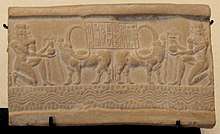
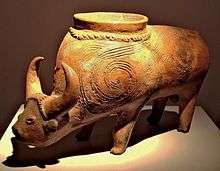
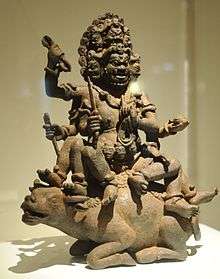
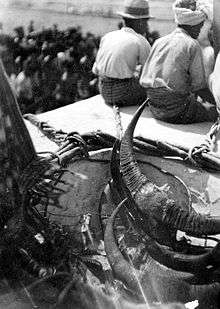
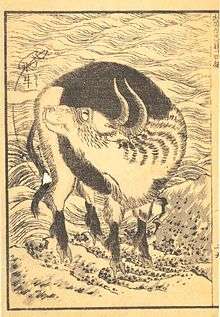
- Some ethnic groups, such as Batak and Toraja in Indonesia and the Derung in China, sacrifice water buffaloes or kerbau (called horbo in Batak or tedong in Toraja) at several festivals.
- In Chinese tradition, the water buffalo is associated with a contemplative life.[65] Legend has it that the Chinese philosophical sage Laozi left China through the Han Gu Pass riding a water buffalo.
- According to Hindu lore, the god Dharmaraja, of Dharma and death, Yama, rides on a male water buffalo.
- In the state of Gujarat and some parts of Rajasthan in India, mostly Rayka as well as many other communities worship the goddess Vihat, who rides on a male water buffalo. She is claimed of having 20 hands and uses a male water buffalo as her Vahana. Also, the goddess Varahi in Indian culture is shown to possess a water buffalo and ride it.
- A water buffalo head was a symbol of death in Tibet.[66]
- According to another folk lore, Mahishasura, a half-buffalo and half-human demon, was killed by the goddess Durga.
- The Yoruban Orisha Oya (the goddess of change) takes the form of a water buffalo.
- The Carabao buffalo is considered a national symbol of the Philippines, although this has no basis in Philippine law.[67]
- In Vietnam, water buffaloes are often the most valuable possession of poor farmers: 'Con trâu là đầu cơ nghiệp'. They are treated as a member of the family: "Chồng cày, vợ cấy, con trâu đi bừa", meaning "the husband plows, the wife sows, the water buffalo draws the rake". Children talk to their water buffalo: "Bao giờ cây lúa còn bông. Thì còn ngọn cỏ ngoài đồng trâu ăn". Hà Nội used to be named Kim Ngưu—"Golden Water Buffalo".
- Many ethnic groups use the horns of water buffaloes as a game trophy, musical instruments and ornaments.
- In the Thai and Sinhalese animal and planetary zodiac, the water buffalo is the third animal zodiac of the Thai and the fourth animal zodiac of the Sinhalese people of Sri Lanka.[68] Similarly, the water buffalo is the second animal zodiac in the Vietnamese zodiac.
Fighting festivals
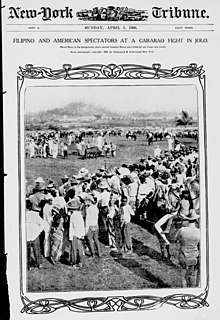

- The Pasungay Festival is held annually in the town of San Joaquin, Iloilo in the Philippines.
- The Moh juj Water Buffalo Fighting Festival is held every year in Bhogali Bihu in Assam.[69]
- The Do Son Water Buffalo Fighting Festival of Vietnam is held each year on the ninth day of the eighth month of the lunar calendar at Do Son Township, Haiphong City in Vietnam. It is one of the most popular Vietnam festivals and events in Haiphong City. The preparations for this buffalo fighting festival begin from the two to three months earlier. The competing water buffalo are selected and methodically trained months in advance. It is a traditional festival of Vietnam attached to a Water God worshiping ceremony and the Hien Sinh custom to show the martial spirit of the local people of Do Son, Haiphong.[70][71]
- The "Hai Luu" Water Buffalo Fighting Festival of Vietnam has existed since the 2nd century B.C. General Lu Gia, at that time, had the water buffalo slaughtered to give a feast to the local people and the warriors, and organized buffalo fighting for amusement. Eventually, all the fighting water buffaloes will be slaughtered as tributes to the deities.[72][73]
- The "Ko Samui" Water Buffalo Fighting Festival of Thailand is a very popular event held on special occasions such as New Year's Day in January, and Songkran in mid-April. This festival features head-wrestling bouts in which two male water buffaloes are pitted against one another. Unlike in Spanish bullfighting, wherein bulls get killed while fighting sword-wielding men, the Buffalo Fighting Festival held at Ko Samui, Thailand is a fairly harmless contest. The fighting season varies according to ancient customs and ceremonies. The first water buffalo to turn and run away is considered the loser; the winning water buffalo becomes worth several million baht.[74]
- The "Ma'Pasilaga Tedong" Water Buffalo Fighting Festival, in Tana Toraja Regency of Sulawesi Island, Indonesia, is a popular event where the Rambu Solo or a Burial Festival takes place in Tana Toraja.
Racing festivals
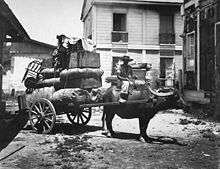
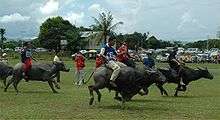
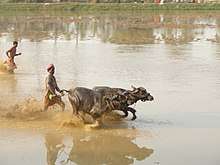
- The Carabao Carroza Festival is being held annually every May in the town of Pavia, Iloilo, the Philippines.
- The Kambala races of Karnataka, India, take place between December and March. The races are conducted by having the water buffaloes (bulls) run in long parallel slushy ditches, where they are driven by men standing on wooden planks drawn by the water buffaloes. The objectives of the race are to finish first and to raise the water to the greatest height. It is also a rural sport. Kambala races are arranged with competition as well as without competition and as a part of thanksgiving (to God) in about 50 villages of coastal Karnataka.
- In the Chonburi Province of Thailand, and in Pakistan, there are annual water buffalo races.
- The Chon Buri water buffalo racing festival, Thailand[75] In downtown Chonburi, 70 km (43 mi) south of Bangkok, at the annual water buffalo festival held in mid-October. About 300 water buffaloes race in groups of five or six, spurred on by bareback jockeys wielding wooden sticks, as hundreds of spectators cheer. The water buffalo has always played an important role in agriculture in Thailand. For the farmers of Chon Buri Province, near Bangkok, it is an important annual festival, beginning in mid-October. It is also a celebration among rice farmers before the rice harvest. At dawn, farmers walk their water buffaloes through the surrounding rice fields, splashing them with water to keep them cool before leading them to the race field. This amazing festival started over 100 years ago, when two men arguing about whose water buffalo was the fastest ended up having a race between them. That is how it became a tradition and gradually a social event for farmers, who gathered from around the country in Chonburi to trade their goods. The festival also helps a great deal in preserving the numbers of water buffaloes, which have been dwindling at quite an alarming rate in other regions. Modern machinery is rapidly replacing water buffaloes in Thai agriculture. With most of the farm work mechanized, the water buffalo-racing tradition has continued. Racing buffalo are raised just to race; they do not work at all. The few farm buffalo which still do work are much bigger than the racers because of the strenuous work they perform. Farm water buffaloes are in the "Buffalo Beauty Pageant", a Miss Farmer beauty contest and a comedic water buffalo costume contest, etc.. This festival perfectly exemplifies a favored Thai attitude to life — "sanuk," meaning fun.
- The Babulang water buffalo racing festival in Sarawak, Malaysia, is the largest or grandest of the many rituals, ceremonies and festivals of the traditional Bisaya community of Limbang, Sarawak. Highlights are the Ratu Babulang competition and the water buffalo races, which can only be found in this town in Sarawak, Malaysia.
- At the Vihear Suor village water buffalo racing festival, Cambodia,[76] each year, people visit Buddhist temples across the country to honor their deceased loved ones during a 15-day period commonly known as the Festival of the Dead, but in Vihear Suor village, about 22 miles (35 km) northeast of Cambodia, citizens each year wrap up the festival with a water buffalo race to entertain visitors and honour a pledge made hundreds of years ago. There was a time when many village cattle which provide rural Cambodians with muscle power to plow their fields and transport agricultural products died from an unknown disease. The villagers prayed to a spirit to help save their animals from the disease and promised to show their gratitude by holding a water buffalo race each year on the last day of the "P'chum Ben" festival, as it is known in Cambodia. The race draws hundreds of spectators, who come to see riders and their animals charge down the racing field, the racers bouncing up and down on the backs of their water buffaloes, whose horns were draped with colorful cloth.
- Buffalo racing in Kerala is similar to the Kambala races.[77][78]
Religious festival
- The Pulilan Carabao Festival is held annually every 14 and 15 May in the Philippine town of Pulilan in honor of St. Isidore the Laborer, the patron saint of farmers. As thanksgiving for a bountiful harvest every year, farmers parade their carabaos in the main town street, adorning them with garlands and other decorations. One of the highlights of the festival is the kneeling of the carabaos in front of the parish church.[79]
See also
- Cattle in religion
- List of water buffalo breeds
- African buffalo (Syncerus caffer)
- Zebu, the common breed of domestic cattle from India
References
- Cockrill, W. R. (1977). The water buffalo (PDF). Rome: Animal Production and Health Series No. 4. Food and Agriculture Organization of the United Nations.
- Lau, C. H.; Drinkwater, R. D.; Yusoff, K.; Tan, S. G.; Hetzel, D. J. S.; Barker, J. S. F. (1998). "Genetic diversity of Asian water buffalo (Bubalus bubalis): mitochondrial DNA D-loop and cytochrome b sequence variation" (PDF). Animal Genetics. 29 (4): 253–264. doi:10.1046/j.1365-2052.1998.00309.x. PMID 9745663.
- Cockrill, W. R., ed. (1974). The husbandry and health of the domestic buffalo. Rome: Food and Agriculture Organization of the United Nations.
- Yang, D. Y.; Liu, L.; Chen, X.; Speller, C. F. (2008). "Wild or domesticated: DNA analysis of ancient water buffalo remains from north China" (PDF). Journal of Archaeological Science. 35 (10): 2778–2785. doi:10.1016/j.jas.2008.05.010.
- Zhang, Y.; Colli, L.; Barker, J. S. F. (2020). "Asian water buffalo: domestication, history and genetics". Animal Genetics. doi:10.1111/age.12911. PMID 31967365.
- McIntosh, J. (2008). The Ancient Indus Valley: New Perspectives. ABC-CLIO, Santa Barabara.
- Khan, G., Church, S. K., Harding, R., Lunde, P., McIntosh, J., Stone, C. (2011). The First Civilizations in Contact: Mesopotamia and the Indus. The Civilizations in Contact Project, Faculty of Asian and Middle Eastern Studies, University of Cambridge.
- Scherf, B. D. (2000). World watch list for domestic animal diversity. Third edition. Food and Agriculture Organization of the United Nations, Rome.
- Long, J. L. (2003). Introduced Mammals of the World: Their History, Distribution and Influence. Collingwood, Australia: Csiro Publishing. ISBN 9780643099166.
- Linnaeus, C. (1758). "Bos Bubalis". Systema naturæ per regna tria naturæ, secundum classes, ordines, genera, species, cum characteribus, differentiis, synonymis, locis. v.1 (10 ed.). Holmiae: Laurentii Salvii. p. 72.
- Ellerman, J.R.; Morrison-Scott, T. C. S. (1966). "Genus Bubalus H. Smith, 1827". Checklist of Palaearctic and Indian mammals 1758 to 1946 (Second ed.). London: British Museum of Natural History. pp. 383–384.
- Corbet, G.B.; Hill, J.E. (1987). A World List of Mammalian Species, Second edition. London: British Natural History Museum. ISBN 0565009885.
- Groves, C. P. (1971). "Request for a declaration modifying Article 1 so as to exclude names proposed for domestic animals from Zoological Nomenclature". Bulletin of Zoological Nomenclature. 27: 269–272. doi:10.5962/bhl.part.29464.
- International Commission on Zoological Nomenclature (2003). "Opinion 2027 (Case 3010). Usage of 17 specific names based on wild species which are predated by or contemporary with those based on domestic animals (Lepidoptera, Osteichthyes, Mammalia): conserved". Bulletin of Zoological Nomenclature. 60: 81–84.
- Gentry, A.; Clutton-Brock, J.; Groves, C. P. (2004). "The naming of wild animal species and their domestic derivatives" (PDF). Journal of Archaeological Science. 31 (#5): 645–651. doi:10.1016/j.jas.2003.10.006. Archived from the original (PDF) on 10 May 2012.
- Priyanto, D., Suradissastra, K. (2010). Ko-evolusi dan Panarchy: Integrasi Ternak Kerbau dalam Sistem Sosial Etnis Toraja. Seminar dan Lokakarya Nasional Kerbau 2010
- Kochhar, H. P.; Rao, K. B.; Luciano, A. M.; Totey, S. M.; Gandolfi, F.; Basrur, P. K.; King, W. A. (2002). "In vitro production of cattle-water buffalo (Bos taurus - Bubalus bubalis) hybrid embryos". Zygote. 102 (#2): 155–162. doi:10.1017/S0967199402002216. PMID 12056456.
- Wanapat, M.; Ngarmsang, A.; Korkhuntot, S.; Nontaso, N.; Wachirapakorn, C.; Beakes, G.; Rowlinson, P. (2000). A comparative study on the rumen microbial population of cattle and swamp buffalo raised under traditional village conditions in the northeast of Thailand. Asian-Australasian Journal of Animal Sciences 13 (7): 918–921.
- Wanapat, M. (2001). "Swamp buffalo rumen ecology and its manipulation". Proceedings Buffalo Workshop.
- Borghese, A., Mazzi, M. (2005). Buffalo Population and Strategies in the World. Pages 1–39 in Borghese, A. (ed.) Buffalo Production and Research. REU Technical Series 67. Inter-regional Cooperative Research Network on Buffalo, FAO Regional Office for Europe, Rome.
- Barile, V. L. (2005). "Reproductive Efficiency in Female Buffaloes". pp. 77–108 in Borghese, A. (ed.) Buffalo Production and Research. REU Technical Series 67. Inter-regional Cooperative Research Network on Buffalo, FAO Regional Office for Europe, Rome.
- Kumar, S.; Nagarajan, M.; Sandhu, J. S.; Kumar, N.; Behl, V. (2007). "Phylogeography and domestication of Indian river buffalo". BMC Evolutionary Biology. 7: 186. doi:10.1186/1471-2148-7-186. PMC 2140268. PMID 17915036.
- Moioli, B. and A. Borghese (2005). Buffalo Breeds and Management Systems. Pages 51–76 in Borghese, A. (ed.) Buffalo Production and Research. REU Technical Series 67. Inter-regional Cooperative Research Network on Buffalo, FAO Regional Office for Europe, Rome.
- Kumar, S.; Nagarajan, M.; Sandhu, J. S.; Kumar, N.; Behl, V.; Nishanth, G. (2007). "Mitochondrial DNA analyses of Indian water buffalo support a distinct genetic origin of river and swamp buffalo" (PDF). Animal Genetics. 38 (#3): 227–232. doi:10.1111/j.1365-2052.2007.01602.x. PMID 17459014.
- Tanaka, K., Solis, C. D., Masangkay, J. S., Maeda, K., Kawamoto, I. Y. and Namikawa, T. (1996). Phylogenetic relationship among all living species of the genus Bubalus based on DNA sequences of the cytochrome b gene. Biochemical Genetics 34: 443–452.
- Pérez-Pardal, L.; Chen, S.; Costa, V.; Liu, X.; Carvalheira, J.; Beja-Pereira, A (2018). "Genomic differentiation between swamp and river buffalo using a cattle high-density single nucleotide polymorphisms panel" (PDF). Animal. 12 (3): 464–471. doi:10.1017/S1751731117001719. PMID 28735584.
- Sun, T.; Shen, J.; Achilli, A.; Chen, N.; Chen, Q.; Dang, R.; Zheng Z; Zhang, H.; Lei, C.; Zhang, X.; Wang, S.; Zhang, T.; Lu, H.; Ma, Y.; Jia, Y.; Capodiferro, M.R.; Huang, Y.; Lan, X.; Chen, H. & Jiang, Y. (2020). "Genomic analyses reveal distinct genetic architectures and selective pressures in buffaloes". Gigascience. 9 (2): giz166. doi:10.1093/gigascience/giz166. PMID 32083286.
- Borghese, A. (2011). "Situation and Perspectives of Buffalo in the World, Europe and Macedonia". Macedonian Journal of Animal Science 1 (#2): 281–296.
- Singh, C. V. and R. S. Barwal (2010). Buffalo Breeding Research and Improvement Strategies in India. Pages 1024–1031 in The Buffalo in the World. Proceedings of the 9th World Buffalo Congress, Buenos Aires, April 2010.
- Agricultural Census Commission (2012). Pakistan Agricultural Census 2010. Government of Pakistan, Statistics Division, Agricultural Census Organization, Lahore.
- FAO (2013). Breeds reported by Pakistan: Buffalo. Domestic Animal Diversity Information System, Food and Agriculture Organisation of the United Nations, Rome.
- Uriyapongson, S. (2013). Buffalo and Buffalo Meat in Thailand. Buffalo Bulletin 32: 329–332.
- Abid, H. (2007). "Water Buffalo in the Iraqi Marshes". Nature Iraq: 29.
- Lydekker, R. (1898). "The Indian buffalo – Bos bubalis". Wild Oxen, Sheep, and Goats of all Lands. London: Rowland Ward. pp. 118–128.
- Letts, G. A. (1964). "Feral Animals in the Northern Territory". Australian Veterinary Journal. 40 (3): 84–88. doi:10.1111/j.1751-0813.1964.tb01703.x.
- "The feral water buffalo (Bubalus bubalis)]. Fact Sheet" (PDF). Australian Department of Sustainability, Environment, Water, Population and Communities. Retrieved 17 July 2012.
- Sharp, K. (2009). Frontier to the Crossroads. Outback Magazine 67:
- ABC website Buffalo exports still suffering June 10, 2013
- Sheikh, Pervaze A.; Merry, Frank D.; McGrath, David G. (2006). "Water buffalo and cattle ranching in the Lower Amazon Basin: Comparisons and conflicts". Agricultural Systems. 87 (#3): 313–330. doi:10.1016/j.agsy.2005.02.003.
- National Research Council (U.S.). (2002). The Water Buffalo: New Prospects for an Underutilized Animal : Report. National Academy Press, Washington, D.C.
- "Buffalos find home on the kitchen range // Sought-after meat lower than beef in cholesterol, fat" (1989). Austin American Statesman: D3
- Mehren, E. (2003). "Water buffalo enlisted for Vermont venture" Chicago Tribune.
- Mehren, E. (2003). "A Taste of Italy, Via Vermont" (2003). Los Angeles Times
- "Buffalo make the mozzarella". Los Angeles Times. Associated Press (2006).
- Fletcher, J. (2006). "Buffalo milk's curds and whey". San Francisco Chronicle.
- "FAOSTAT". fao.org. Retrieved 25 October 2019.
- D'Ambrosio, C.; Arena, S.; Salzano, A. M., Renzone, G.; Ledda, L. and Scaloni, A. (2008). "A proteomic characterization of water buffalo milk fractions describing PTM of major species and the identification of minor components involved in nutrient delivery and defense against pathogens". Proteomics. 8 (#17): 3657–3666. doi:10.1002/pmic.200701148. PMID 18668696.
- Khan, M. A. S.; Islam, M. N.; Siddiki, M. S. R. (2007). "Physical and chemical composition of swamp and water buffalo milk: a comparative study". Italian Journal of Animal Science. 6 (Suppl. 2): 1067–1070. doi:10.4081/ijas.2007.s2.1067.
- Han, X.; Lee, F. L.; Zhang, L. and M. R. Guo (2012). "Chemical composition of water buffalo milk and its low-fat symbiotic yogurt development" (PDF). Functional Foods in Health and Disease. 2 (#4): 86–106. doi:10.31989/ffhd.v2i4.96.
- Borghese, A. (2005). "Buffalo Cheese and Milk Industry". In Borghese, A. (ed.). Buffalo Production and Research. REU Technical Series 67. Rome: Inter-regional Cooperative Research Network on Buffalo, FAO Regional Office for Europe. pp. 185–195.
- Food And Agricultural Organization of United Nations: Economic And Social Department: The Statistical Division
- "Why Wear Horn Earrings?" (PDF). Bandaru Organics. Retrieved 14 August 2014.
- BBC News February 2004 Buffalo improve wildlife habitat
- "Buffaloes and wetlands" -- grazing in wetland management: A discussion from the Ramsar Forum over late March 1998
- Natural England (2008). "Buffalo improve wildlife habitat in Cambridgeshire". Natural England East of England press office.
- Roth, J. & P. Myers (2004). "Bubalis Bubalis". University of Michigan Museum of Zoology Animal Diversity Web.
- Hicap, J. M. (2007). "RP to produce Southeast Asia's first cloned buffalo". The Manila Times.
- Uy, Jocelyn (2007). "'Super carabao' making the scene in year of the rats".
- Samrupa, World's first cloned buffalo calf from India. Retrieved from Topinews.com
- 2010. India. Parliament. House of the People, India. Parliament. Lok Sabha, pp.151.]
- DNA India - CIRB becomes India's second centre to produce a cloned buffalo, 2016
- "Cylinder Seal of Ibni-Sharrum". Louvre Museum.
- "Site officiel du musée du Louvre". cartelfr.louvre.fr.
- Brown, Brian A.; Feldman, Marian H. (2013). Critical Approaches to Ancient Near Eastern Art. Walter de Gruyter. p. 187. ISBN 9781614510352.
- Tressider, Jack (1997). The Hutchinson Dictionary of Symbols. London: Helicon Publisher. p. 31. ISBN 1-85986-059-1.
- Tressider, Jack (1997). The Hutchinson Dictionary of Symbols. London: Helicon Publishers. p. 31. ISBN 1-85986-059-1.
- Pangilinan, Jr., Leon (3 October 2014). "In Focus: 9 Facts You May Not Know About Philippine National Symbols". National Commission for Culture and the Arts. Retrieved 8 January 2019.
- Upham, E. (1829). The History and Doctrine of Budhism: Popularly Illustrated: with Notices of the Kappooism, Or Demon Worship, and of the Bali, Or Planetary Incantations, of Ceylon. London: R. Ackermann.
- Dutta, P. (2008). "Bonfire, feast & lots more". The Telegraph. Calcutta, India. Retrieved 19 January 2008.
- Do Son: buffalo fighting festival (Vietnam), 14 September 2005, VietNamNet Bridge
- Do Son Buffalo Fighting Festival Vietnam, Asiarooms.com
- Buffalo Fighting in Hai Luu Commune, Vietnam News Agency
- VIDEO on YouTube:Water Buffalo-fighting festival
- Koh Samui Point (2017). Buffalo Fighting
- Buffalo Racing, Thailand, thailand-guide.org (p) some content provided by Tourism Authority of Thailand, Last Updated : 1 July 2007; Watching the Buffalo Racing, by Panrit "Gor" Daoruang, 14 October 2003, Thailand Life; Running of the buffalo: Thais take their beasts of burden to the races; by: Alisa Tang, Associated Press Writer; Buffalo Racing, The lowdown by Aliwyn Cole, 1 August 2005, Urban Lowdown; "Running with the Buffalo", originally published in the Learning Post, a supplement of the Bangkok Post
- Buffalo Racing in Cambodia, 27 September 2006
- "Bull race held at Kaakkoor peacefully". The Hindu. Chennai, India. 27 February 2004.
- "'Maramadi' winners". The Hindu. Chennai, India. 27 February 2004.
- "Pulilan Carabao Festival (Pulilan, Bulacan)". Experience Bulacan. Provincial Government of Bulacan. Retrieved 26 December 2016.
Further reading
- Clutton-Brock, J. 1999. A Natural History of Domesticated Mammals. Cambridge, UK: Cambridge University Press. ISBN 0-521-63495-4.
- Fahimuddin, M. 1989. Domestic Water Buffalo. Janpath, New Delhi: Oxford & IBH Publishing Co. Pvt. Ltd. ISBN 81-204-0402-5.
- Guinness Book of Records, 2005.
- The Water Buffalo: New Prospects for an Underutilized Animal. Washington, D.C. 1981. National Academy Press. ISBN 978-0-309-04159-1.
- Nowak, R. M. and Paradiso, J. L. 1983. Walker's Mammals of the World. Baltimore, Maryland: The Johns Hopkins University Press. ISBN 0-8018-2525-3.
- Roth, J. and P. Myers. "Bubalis Bubalis", University of Michigan Museum of Zoology Animal Diversity Web. Retrieved 15 January 2009
- Ruangprim, T. et al. 2007. "Rumen microbes and ecology of male dairy, beef cattle and buffaloes". In: Proceedings Animal Science Annual Meeting, Khon Kaen University, Khon Kaen 40002, Thailand.
- Thu, Nguyen Van and T. R. Preston. 1999. "Rumen environment and feed degradability in swamp buffaloes fed different supplements". Livestock Research for Rural Development 11 (3)
- Voelker, W. 1986. The Natural History of Living Mammals. Medford, New Jersey: Plexus Publishing, Inc. ISBN 0-937548-08-1.
- Wanapat, M. 2000. "Rumen manipulation to increase the efficient use of local feed resources and productivity of ruminants in the tropics". Asian-Aust. J. Anim. Sci. 13(Suppl.): 59–67.
- Wanapat, M. and P. Rowlinson. 2007. "Nutrition and feeding of swamp buffalo: Feed resources and rumen approach". Paper to be presented at the VIII World Buffalo Congress, 19–22 October 2007, Caserta, Italy, organized by The International Buffalo Federation.
- Wilson, D. E. and Reeder, D. M. 1993. Mammal Species of the World: A Taxonomic and Geographic Reference, Second Edition. Smithsonian Institution.
External links
| Wikimedia Commons has media related to Water buffalo. |
| Wikispecies has information related to Water buffalo |
| Wikisource has the text of an 1879 American Cyclopædia article about Water buffalo. |
- Buffalopedia, created by Central Institute for Research on Buffaloes at Hisar city, Haryana state, India.
- Animal Info: Wild Asian (Water) Buffalo
- Creature features: Buffaloes
- Feral buffalo in Australia
- Breeds of Livestock: Murrah
- National Agricultural Innovation Project: Identification of Quantitative Trait Loci for Milk yield, Fat and Protein Percent in Buffaloes
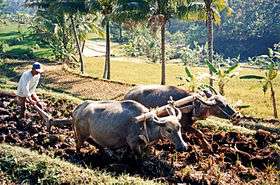
.jpg)
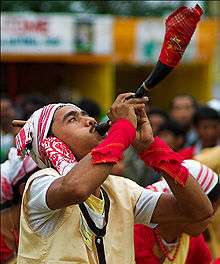
.jpg)